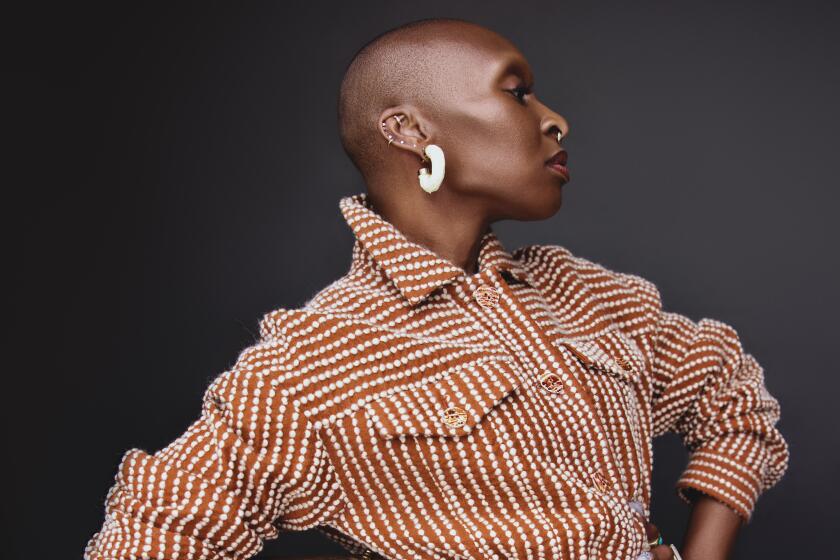Chris Burden’s architectural intelligence
- Share via
I remember very clearly the first time I heard Renzo Piano describe the new plaza he was planning for the expanded Los Angeles County Museum of Art. It must have been 2005. The Italian architect told me he wanted to create a spacious, classically proportioned space stretching between the museum’s new ticket kiosks and Wilshire Boulevard.
“A piazza,” he called it, with more pride than irony about how such a romantic notion would play in the middle of Los Angeles.
Artist Chris Burden and Michael Govan, who became LACMA director in 2006, came up with a different idea. Burden, who died Sunday at 69, had been collecting cast-iron lampposts from Southern California streets and storing them at his compound in Topanga Canyon. He painted more than 200 of them a uniform gunmetal gray, arranged them in the shape of an abstract, open-air building and called the piece “Urban Light.”
When Govan decided to install the artwork right in the middle of Piano’s completed plaza, the piazza idea was essentially ruined, or at least dramatically undermined. But something else emerged in its place: A public space that no longer tried to ape European precedents but instead seemed entirely home in contemporary Los Angeles.
Here were deeply familiar symbols of car culture brought together into a quasi-architectural shape and used, without sarcasm or apology, to suggest an emerging role for the pedestrian and the public realm in 21st century Southern California. If the sculpture was far from an announcement that the car was on its way out, it at least pointed the way to a new era. And announced that new eras require new monuments.
That “Urban Light” is also ridiculously photogenic has given a significant boost to LACMA’s goal of activating the long-dormant seam between the museum and the boulevard. And if there are quite a few selfie sticks in use at the sculpture these days, that seems fitting. It is a temple that makes room for many kinds of belief, raging self-regard quite comfortably among them.
The fundamentally architectural character of “Urban Light” -- the artist called it “a building with a roof of light” -- was no anomaly for Burden, who grew up in France and Italy and studied at Pomona College and UC Irvine. Themes connected to architecture and urbanism run through his work, typically with the same wry attitude about the relationship between structure and art-making that the lampposts suggest.
“Originally I was going to study architecture,” Burden said at a lecture at the Southern California Institute of Architecture in 2003. “Pomona College didn’t have a specific architectural program, so you took physics classes and art classes, and that was considered how you got your BFA in architecture. As time went on, I realized that I wanted to be an artist, mostly because I had worked a couple summers in an architectural office and seemed then to me that you had to be my age -- that I am now -- before you got to make any decisions. Whereas in sculpture I could get something done right away. So that’s the path I chose.”
He added: “Also, the physics at Pomona got harder and harder and I was competing with sort of the whiz kids of the physics world. They were content to spend 30 to 40 hours on a calculus equation. That wasn’t interesting to me.”
Some of Burden’s work wound up being explicitly architectural. Some was closer to architecture criticism. In 1990, in a piece called “Wexner Castle,” Burden made some additions to the exterior of Peter Eisenman’s new Wexner Center for the Arts in Columbus, Ohio.
Eisenman had wrapped the building in brick fragments that were meant to recall an armory that once stood on the site. But for Burden the brick towers were too smooth and abstract, missing crenelation and other details. He had those features fabricated and attached them to Eisenman’s façade -- a sculptor adding architectural details to a piece of architecture he found too blithely and lazily sculptural.
In 2013, New York’s New Museum mounted a major exhibition of Burden’s work called “Extreme Measures.” In his first discussions with museum curators, Burden said he wanted to leave the galleries virtually empty and instead hang a range of large pieces, including another collection of lampposts, on the facade of the New Museum’s six-year-old building.
In the end the galleries were full of works by Burden and just two works were attached to the exterior. (Even those were tremendously complicated to bring off.)
“Ghost Ship,” a vessel that Burden had earlier sent on an unmanned voyage, controlled remotely, off the coast of Scotland, hung from the facade. On the museum’s roof was a piece called “Twin Quasi-Legal Skyscrapers,” clearly an homage to the destroyed World Trade Center towers but also a work with deep roots in the quasi-architectural experiments Burden carried out in Topanga Canyon over many years.
In the early 1990s, he sketched out a project called “Small Skyscraper,” which represented the tallest structure you could put up in Los Angeles without a building permit. Working with the L.A. architects Linda Taalman and Alan Koch, Burden built a version of the tower and displayed it in 2003 at Los Angeles Contemporary Exhibitions, where it was shown on its side, and later, upright, at One Colorado in Pasadena.
Burden carried out “a kind of outsider architecture practice,” Taalman said Monday. She added that “Small Skyscraper,” at its core, came down to “evading building inspectors. If someone didn’t like it, you could take it down and it could pop up somewhere else.”
Taalman happened to be at LACMA on Sunday, standing near “Urban Light,” when she got a text that Burden had died. He’d kept news of his declining health largely private; she hadn’t known he was terminally ill. She stayed there for a few minutes and watched people interact with the artwork.
“It’s amazing the way people are drawn to that sculpture,” she said. “It never stops. People are like moths, drawn to those lights.”
It’s true. I spent a few hours there on Sunday evening and marveled, as I always do, at the same dynamic.
Burden understood that what LACMA and Wilshire Boulevard needed was not a void but a magnet. In the dense European cities Renzo Piano knows well, an empty plaza is attractive as a relief from both people and architecture, from the weight of masonry and history. It pulls you in as a place where the city has a chance to catch its breath.
In Los Angeles we have a surplus of empty space, much of it in the form of parking lots. An open plaza is not a relief or an attraction in its own right. It is a way of letting more air out of a balloon that we’ve been struggling for several decades to fill.
As Burden said more than once, L.A. is short on both monuments and gathering spots. In this city, at least for now, you need one to make the other.
Follow me on Twitter: @HawthorneLAT
More to Read
The biggest entertainment stories
Get our big stories about Hollywood, film, television, music, arts, culture and more right in your inbox as soon as they publish.
You may occasionally receive promotional content from the Los Angeles Times.











